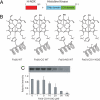A structural basis for H-NOX signaling in Shewanella oneidensis by trapping a histidine kinase inhibitory conformation
- PMID: 19918063
- PMCID: PMC2785238
- DOI: 10.1073/pnas.0911645106
A structural basis for H-NOX signaling in Shewanella oneidensis by trapping a histidine kinase inhibitory conformation
Abstract
Heme nitric oxide/oxygen (H-NOX) proteins are found in eukaryotes where they are typically part of a larger protein such as soluble guanylate cyclase and in prokaryotes where they are often found in operons with a histidine kinase, suggesting that H-NOX proteins serve as sensors for NO and O(2) in signaling pathways. The Fe(II)-NO complex of the H-NOX protein from Shewanella oneidensis inhibits the autophosphorylation of the operon-associated histidine kinase, whereas the ligand-free H-NOX has no effect on the kinase. NMR spectroscopy was used to determine the structures of the Fe(II)-CO complex of the S. oneidensis H-NOX and the Fe(II)-CO complex of the H103G H-NOX mutant as a mimic of the ligand-free and kinase-inhibitory Fe(II)-NO H-NOX, respectively. The results provide a molecular glimpse into the ligand-induced conformational changes that may underlie kinase inhibition and the subsequent control of downstream signaling.
Conflict of interest statement
The authors declare no conflict of interest.
Figures






Similar articles
-
Nitric oxide-sensing H-NOX proteins govern bacterial communal behavior.Trends Biochem Sci. 2013 Nov;38(11):566-75. doi: 10.1016/j.tibs.2013.08.008. Epub 2013 Oct 7. Trends Biochem Sci. 2013. PMID: 24113192 Free PMC article. Review.
-
Shewanella oneidensis MR-1 H-NOX regulation of a histidine kinase by nitric oxide.Biochemistry. 2007 Dec 4;46(48):13677-83. doi: 10.1021/bi7019035. Epub 2007 Nov 8. Biochemistry. 2007. PMID: 17988156 Free PMC article.
-
Nitric Oxide-Induced Conformational Changes Govern H-NOX and Histidine Kinase Interaction and Regulation in Shewanella oneidensis.Biochemistry. 2017 Mar 7;56(9):1274-1284. doi: 10.1021/acs.biochem.6b01133. Epub 2017 Feb 21. Biochemistry. 2017. PMID: 28170222
-
Is histidine dissociation a critical component of the NO/H-NOX signaling mechanism? Insights from X-ray absorption spectroscopy.Dalton Trans. 2012 Jul 14;41(26):7984-93. doi: 10.1039/c2dt30147d. Epub 2012 Mar 20. Dalton Trans. 2012. PMID: 22430114 Free PMC article.
-
Structural Insight into H-NOX Gas Sensing and Cognate Signaling Protein Regulation.Chembiochem. 2019 Jan 2;20(1):7-19. doi: 10.1002/cbic.201800478. Epub 2018 Nov 8. Chembiochem. 2019. PMID: 30320963 Review.
Cited by
-
H-NOX from Clostridium botulinum, like H-NOX from Thermoanaerobacter tengcongensis, Binds Oxygen but with a Less Stable Oxyferrous Heme Intermediate.Biochemistry. 2015 Dec 8;54(48):7098-109. doi: 10.1021/acs.biochem.5b00994. Epub 2015 Nov 25. Biochemistry. 2015. PMID: 26574914 Free PMC article.
-
Probing the Molecular Mechanism of Human Soluble Guanylate Cyclase Activation by NO in vitro and in vivo.Sci Rep. 2017 Feb 23;7:43112. doi: 10.1038/srep43112. Sci Rep. 2017. PMID: 28230071 Free PMC article.
-
Nitric oxide-sensing H-NOX proteins govern bacterial communal behavior.Trends Biochem Sci. 2013 Nov;38(11):566-75. doi: 10.1016/j.tibs.2013.08.008. Epub 2013 Oct 7. Trends Biochem Sci. 2013. PMID: 24113192 Free PMC article. Review.
-
Solution structures of the Shewanella woodyi H-NOX protein in the presence and absence of soluble guanylyl cyclase stimulator IWP-051.Protein Sci. 2021 Feb;30(2):448-463. doi: 10.1002/pro.4005. Epub 2020 Dec 10. Protein Sci. 2021. PMID: 33236796 Free PMC article.
-
Bacterial Heme-Based Sensors of Nitric Oxide.Antioxid Redox Signal. 2018 Dec 20;29(18):1872-1887. doi: 10.1089/ars.2017.7235. Epub 2017 Sep 28. Antioxid Redox Signal. 2018. PMID: 28847157 Free PMC article. Review.
References
-
- Derbyshire ER, Marletta MA. Biochemistry of soluble guanylate cyclase. Handb Exp Pharmacol. 2009:17–31. - PubMed
-
- Chan MK. Recent advances in heme-protein sensors. Curr Opin Chem Biol. 2001;5:216–222. - PubMed
-
- Boon EM, Huang SH, Marletta MA. A molecular basis for NO selectivity in soluble guanylate cyclase. Nat Chem Biol. 2005;1:53–59. - PubMed
-
- Huang SH, Rio DC, Marletta MA. Ligand binding and inhibition of an oxygen-sensitive soluble guanylate cyclase, Gyc-88E, from Drosophila. Biochemistry. 2007;46:15115–15122. - PubMed
Publication types
MeSH terms
Substances
Associated data
- Actions
- Actions
Grants and funding
LinkOut - more resources
Full Text Sources

